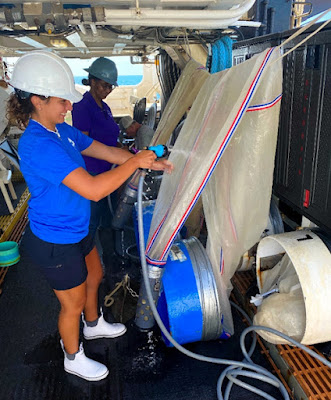 |
Geaceli G. Orive holding a common
jellyfish (Aurelia
aurita) while abroad an ichthyoplanktonsurvey.
|
Hello everyone, allow me to introduce myself! My name is Geaceli G. Orive (also known as “G”), and I am a NOAA EPP/MSI CCME-II Scholar. I am currently a graduate student pursuing my masters . in Ocean, Coastal, and Earth Sciences at the University of Texas at Rio Grande Valley (UTRGV). My thesis focuses on genetic connectivity of Gray Triggerfish (
Balistes capriscus) in the Mexican Caribbean, the southern and northwestern Gulf of Mexico (GOM). I received my B.S. in Marine Biology with a minor in photography in Spring 2022 at UTRGV. I am interested in place-based conservation, which is an often-overlooked topic that enhances the scientific understanding of human interactions with the coastal environment.
During Fall of 2023, I had the incredible opportunity to a be NOAA Experiential Research and Training Opportunities (NERTO) Intern at the Southeast Fisheries Science Center (SFSC) in Pascagoula, Mississippi. This center is a branch of NOAA’s National Marine Fisheries Service (NMFS). My project involved analyzing the changes in
Sargassum habitat community structure from offshore to inshore areas in the northern Gulf of Mexico (east to west). I assisted with two ichthyoplankton surveys aboard a NOAA vessel (Gordon Gunter) which involved collecting and processing various samples (e.g. invertebrates) in order to identify and quantify early life stages of these
Sargassum habitat associated organisms. I gained experience on two research cruises which also supported my professional development. For example, I learned about the fishing techniques in collaboration with the existing fisheries independent survey (Southeast Area Monitoring and Assessment Program (SEAMAP)) and how to perform ichthyoplankton surveys. It was absolutely amazing to be out at sea, gain a hands-on experience and witness the breathtaking views (fantastic marine organisms, endless sea, a plethora of stars, and glorious sunrises and sunsets).
 |
Geaceli G. Orive (front) and NOAA Scientist Pamela Brown (back)
washing
down bongo nets after collecting specimens. |
Since my surveys collected a limited sample of
Sargassum, historical data (2003 – 2019) was incorporated into my project, which) involved the community structure of fishes and invertebrates’ larvae associated with
Sargassum habitat. For this approach, a comparison of community structure (i.e., species richness, abundances, diversity, evenness, and similarities/dissimilarities) between fishes and invertebrates among years and between the East vs. West GOM was performed. Noteworthy, ichthyoplankton surveys take place during Spring and Fall nearly year. However, SFSC focuses on different sampling areas (nearshore vs. offshore), hence this study did not compare community structure attributes between seasons.
Ultimately, I expanded my skills in collecting, processing, and analyzing fishery-independent data in studies on habitat and community structure. This research is a relevant component of Ecosystem Based Fisheries Management (EBFM) and understanding how results from fish and invertebrate samples can be incorporated into the management of Sargassum in the northern GOM. I assisted in the development of research dissemination products to show the relevance of these results for fisheries management. Through this opportunity, I also gained an understanding of the responsibilities of a NOAA research laboratory and collaborated with like-minded peers who are passionate about healthy oceans. Moreover, I increased my skillset that are useful in a variety of academic, agency and NGO settings.
 |
| Geaceli G. Orive in front of the NOAA research vessel, Gordon Gunter |
 |
Rain or shine, sampling was always
underway (Pictured: Geaceli G. Orive).
|
This NERTO contributed to the activities and priorities of SFSC which aligns with the broader NOAA mission. Further, this NERTO aligns with the CCME-II goals to provide training and tools that comprehend and respond to challenges that face coastal and marine communities.
I am extremely grateful to be a part of this program and broaden my knowledge of the science that supports healthy oceans. This experience allowed me to increase my confidence in this field, nourish my love for the sea and contribute to the exploration of our marvelous yet mysterious oceans. This NERTO elevated my growth as scholar, overall person and is in invaluable steppingstone to endless career opportunities.
My support for this internship is through the NOAA CCME-II (support from the NOAA Educational Partnership Program with Minority-Serving Institutions, Cooperative Agreement Award #NA21SEC4810004).
 |
| A tranquil sunset picture captured at sea on the Gulf of Mexico |










No comments:
New comments are not allowed.